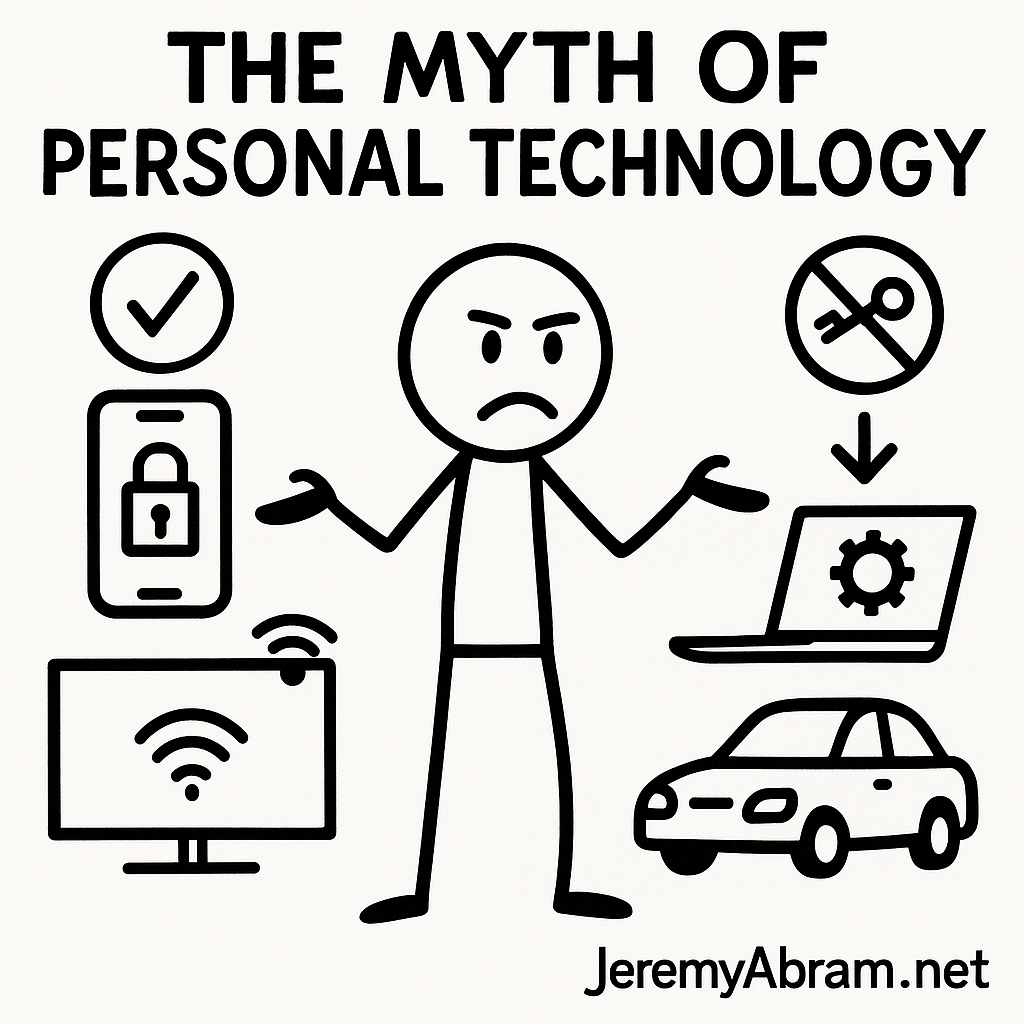
Why your devices don’t truly belong to you — ownership illusions, remote control, and digital power
We like to believe we own our technology.
We buy the phone. We unbox the laptop. We drive the connected car off the lot.
But in the modern digital ecosystem, possession is not ownership — not in the traditional sense. Increasingly, we are customers of devices we think we own, locked into ecosystems that retain the real power: the ability to dictate use, access, modification, and even survival of the product itself.
This is the myth of personal technology — the illusion that our digital machines exist under our control, when in reality, we rent participation in tightly managed systems.
When You “Own” Something — But Don’t
From property to licensed access
Historically, to buy something meant you could repair it, modify it, resell it, or pass it down. A tool was your tool. A machine was your machine.
Today’s devices operate under a different philosophy:
You own the hardware.
You license the software.
That distinction gives corporations unprecedented leverage — because software is now the soul of every device. Without it, the hardware is a brick.
And whoever controls the software controls the object.
The New Powers of Digital Ownership
The transition to digital control introduced three core levers of power corporations retain over your devices:
1. Software Gatekeeping
Your phone can refuse to install apps not blessed by the platform.
Your laptop can block “unauthorized” repairs or components.
Your TV tracks usage and pushes ads even after purchase.
The company — not you — determines functionality.
2. Remote Access and Enforcement
Most modern devices have silent capabilities you never asked for, including:
- Remote disable keys
- Forced updates
- Remote wiping
- Telemetry collection
- Activation locks
- Geofencing controls
If a company decides your device should stop functioning, it can — without stepping foot in your home.
3. Terms That Change After Purchase
Imagine buying a car, only to have:
- Heating features locked behind a monthly subscription
- Performance modified without your consent
- Functions removed due to a licensing dispute
This isn’t hypothetical — it’s already happening across automotive and consumer tech.
Your purchase isn’t final.
It’s conditional — revocable at any time.
Why This Happened
The shift from ownership to permission
Three major forces created this new digital property landscape:
| Force | Effect |
|---|---|
| Software-defined everything | Hardware now depends on remote code and updates |
| Subscription economics | Corporate incentive shifted toward continual ownership of users |
| Anti-repair ecosystems | Control retains revenue — and prevents autonomy |
In this model, users are not owners.
They’re permissioned participants in a corporate computing network.
The Human Cost: Autonomy, Privacy, Agency
Technology promised empowerment. But restrictions on ownership quietly reshaped that promise into dependency.
Autonomy Erodes
You can’t modify the device.
You can’t fix it without permission.
You can’t choose your own digital ecosystem.
Instead of tools, we have chaperoned machines.
Privacy Contracts Away
We trade sovereignty for convenience.
And in doing so, we grant corporations continuous visibility and behavioral influence.
Agency Becomes Illusory
The interface feels like freedom.
The underlying system is control.
The Right-to-Repair and Digital Self-Sovereignty Movements
Resistance is rising.
Advocates push for:
- Fair repair rights
- Open-source interfaces
- True digital ownership
- Permanent functionality after purchase
- Transparency into device capabilities
The tension between corporate control and user autonomy is becoming a defining issue of the digital age.
Future generations may look back at this moment as the turning point — the time we realized our machines obeyed someone else.
A Future Where We Actually Own Our Tools
There is a path back to true digital sovereignty:
- Devices that function without cloud dependency
- Software we control, not rent
- Open hardware and transparent firmware
- Rights to repair, modify, and repurpose
- User-controlled data flows
- Local-first computing and decentralized services
Technology doesn’t have to mean surrender.
It can — and should — be liberation.
But first we must acknowledge the truth:
Our devices do not belong to us until our freedom to use, fix, and control them is restored.
The myth of personal technology breaks when we ask,
“Who really holds the keys?”
© Jeremy Abram — JeremyAbram.net
Leave a Reply